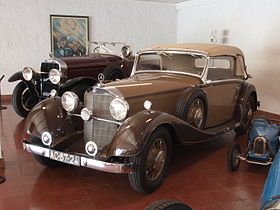Mercedes-Benz 380 (1933)
| Mercedes-Benz W22 | |
|---|---|

Mercedes-Benz 380 "Cabriolet C" (1934)
|
|
| Overview | |
| Manufacturer | Mercedes-Benz |
| Also called | Mercedes-Benz Typ 380 Mercedes-Benz 15/90 PS Mercedes-Benz 15/120 PS Mercedes-Benz 15/140 PS |
| Production | 1933–1934 154 units |
| Assembly | Stuttgart, Germany |
| Body and chassis | |
| Class | Large luxury car |
| Body style |
Torpedo bodied 2 door “Tourenwagen” 4 door "Limousine" (sedan/saloon) Roadster 2 door Cabriolets (various) Also listed in bare chassis form |
| Layout | FR layout |
| Powertrain | |
| Engine | 3,820cc Inline-eight engine without or with "Kompressor" (Supercharger) 90 PS (66 kW; 89 hp), 120 PS (88 kW; 118 hp) or 140 PS (103 kW; 138 hp) |
| Dimensions | |
| Wheelbase | 3,140 mm (124 in) |
| Length | 4,690 mm (185 in) |
| Width | 1,730 mm (68 in) |
| Height | 1,620 mm (64 in) |
The Mercedes-Benz Typ 380 is an eight-cylinder powered automobile introduced by the German manufacturer Mercedes-Benz at the Berlin Motor Show in February 1933. It was withdrawn from production during 1934. Several models with similar names were produced by Mercedes-Benz during the 1930s (and again in the 1980s), so that in retrospect the car is frequently identified using the manufacturer's Works Number as the Mercedes-Benz W22. (The car is sometimes referred to as the Mercedes-Benz Typ 380 K, presumably because of the "Kompressor" (Supercharger) fitted on the faster cars, but this designation was never officially used by the manufacturer.)
In 1933, the Mercedes-Benz 380 sports tourer was one of the most advanced cars on the market, and was duly admired although in the end, with only 154 produced over two years, it proved in some respects a resounding failure.
The engines started out as the 3,820cc straight-eight from the car's predecessor, but the side-valves in the earlier car were now replaced by overhead valves. A new "Mercedes-Benz twin carburetor" was also fitted. More newsworthy was the availability of a "Kompressor" (Supercharger) which instantly established the car's credentials as technologically advanced and which with the benefit of hindsight applied an approach which became mainstream in the auto-industry only half a century later.
The least powerful version carried the engine code "M22". It came without a compressor and provided a listed maximum output of 90 PS (66 kW; 89 hp) at 3,200 rpm. This supported a claimed top speed of 120 km/h (75 mph).
Adding a "Kompressor" raised the maximum output to 120 PS (88 kW; 118 hp) at 3,400 rpm. The listed top speed with this engine was 130 km/h (81 mph).
The car was also available with an "Integrated Kompressor" (mit integriertem Kompressor) which changed the engine code to "M22K" and further raised the maximum power to 140 PS (103 kW; 138 hp), now at 3,600 rpm. Top speed was 135 km/h (84 mph) or 145 km/h (90 mph) according to the final drive ratio fitted.
There is also mention of a version with total cylinder capacity bored out to 4019cc and maximum output raised, using an "integrated Kompressor", to 144 PS (106 kW; 142 hp), with performance further enhanced.
...
Wikipedia
